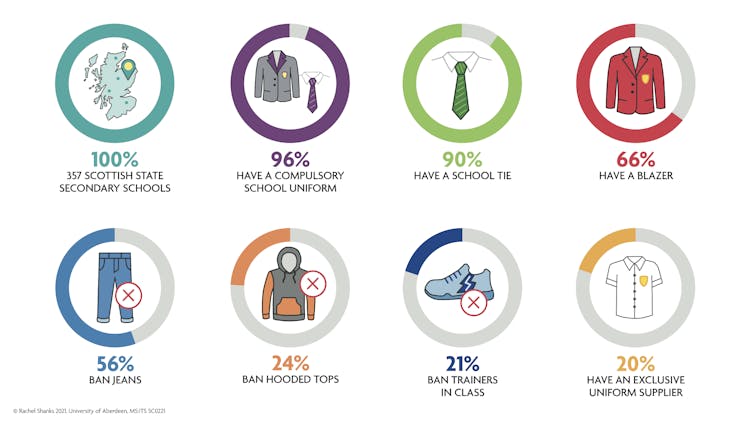
In France, MPs have recently considered whether to reintroduce compulsory school uniform, with first lady Brigitte Macron adding her support to the idea. “It erases differences, it saves time,” she said. These perceptions of the benefits of uniform are widely held – but do they hold up?
French MPs voted against the idea, but uniform is the norm in the UK and has a long history – one which predates universal primary education. This tradition is reinforced in popular media representations of school in the UK, such as the St Trinian’s and Harry Potter films. Uniform requirements may cover what is worn to and from school as well as what is worn in the classroom, and also for physical education.
To understand whether school uniform works or is beneficial, we have to consider what uniforms are meant to achieve. Together with students at the University of Aberdeen, I carried out research on school uniform at all 357 publicly funded secondary schools in Scotland.
We found that 96% of these secondary schools had a compulsory uniform. In our analysis of the school uniform policies, we found a variety of reasons being given to justify compulsory uniforms, with an emphasis on it being in pupils’ own interest.
The most common reason given by schools for this stance was that uniform fosters an ethos, identity, pride and sense of belonging. Other reasons included increasing safety and security and reducing truancy, as well as reducing competition and discrimination between students and increasing employability. Schools also said that uniform was beneficial for the reputation of the school and would improve standards of work among pupils.
The Scottish government has recently stated that: “It is recognised that school uniform plays an important part in the engagement of pupils with school, in promoting a sense of identity, belonging and connectedness to school.”
However, it is not possible to identify whether uniform alone improves factors such as identity and belonging, as the introduction or revamping of a school uniform often coincides with other changes such as a new headteacher or senior leadership team within a school.
Looking the same
In a review of research studies, the Education Endowment Foundation did not find a link between wearing a uniform and an improvement in learning. Another review of research has also found no direct link between uniform and academic performance.
The safety and security reason given by Scottish schools is similar to the reason for introducing school uniform in the US in the 1990s: to reduce gang presence and violence in schools there. By making everyone wear the same clothes, people cannot tell which gang you belong to, or which football team you support.
Uniform may provide the perception that a school is safer or more secure, but there is no UK data to back this up. Research from the US found that teachers perceived schools to be more secure, but that it did not affect students’ perceptions of school security.

Africa Studio/Shutterstock
In more than 50 of the schools we studied, pupils were being told that wearing a uniform would be useful for their future working lives or employability, as it replicates the working environment. But there are fewer jobs that require uniforms and many workplaces now have more relaxed dress codes.
What’s more, research has found that uniform had a negative impact on girls, young people from an ethnic or religious minority, and gender-diverse young people. The uniform that these young people were required to wear did not match their needs. For example, girls wearing skirts are less likely to be physically active and can feel objectified.
The cost of uniform
There is also a general feeling that a school uniform provides a “level playing field” – that it makes everyone appear the same. The idea is to prevent competition and discrimination about clothing between pupils, as well as improving discipline in a more holistic way and potentially reducing bullying.
However, instead of creating a level playing field, some uniform policies do the opposite. School uniform can cost more than school clothing grants provided to help with the affordability of a uniform.
There is a national minimum clothing grant in Scotland of £150 per year for eligible pupils in secondary schools, but The Children’s Society estimated that uniform cost £337 a year in 2020. There can be stigma about wearing secondhand uniforms, which is why school uniform banks tend to provide new uniforms.
Many schools have exclusive arrangements with suppliers which can make uniform more expensive. Among the schools in our study, almost 20% had this kind of exclusive arrangement.
Schools may also have a list of items that must be worn in school or PE, as well as a list of items that must not be worn.
School uniform at state secondary schools in Scotland:

Rachel Shanks, Author provided
Banning everyday items makes uniform more expensive. It adds to the cost of the school day for families, and leads to the creation of school uniform banks.
The Cost of the School Day from charity the Child Poverty Action Group helps schools to create uniform policies that all families can afford. If uniforms are used, then enough financial support should be provided to cover the full cost for eligible families. However, there is no solid research base to rely on to support the requirement for uniforms in schools.
Post a Comment